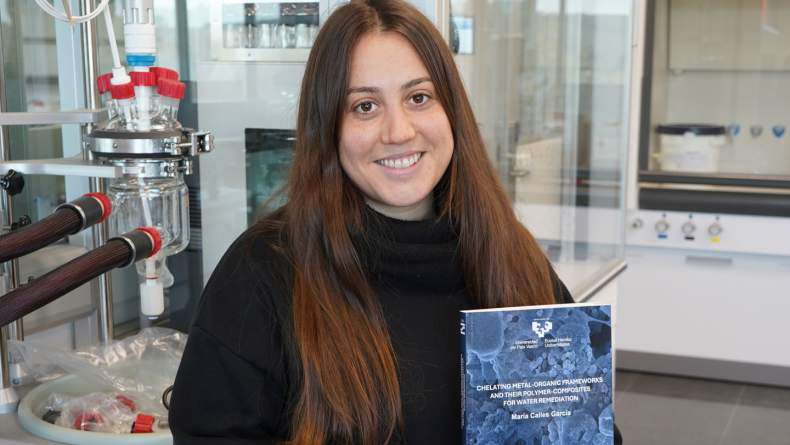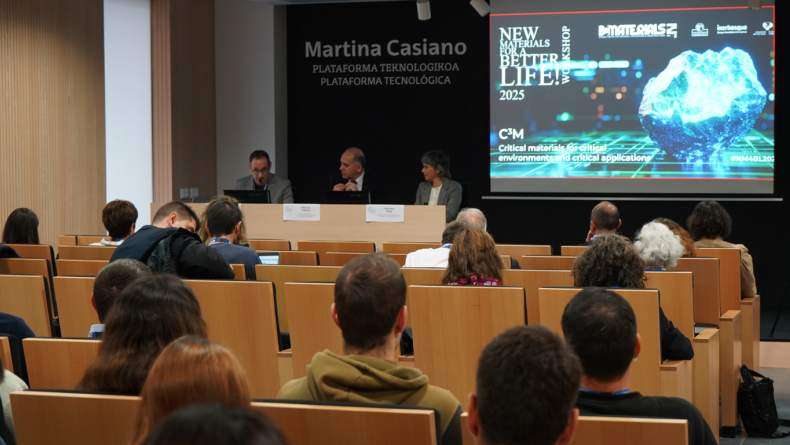BCMaterials Fortnightly Seminars #39

EUGEN SEIF
(BCMaterials)
MAGNETO-THERMOMECHANICAL PROPERTIES OF NIMNGA/POLYMER-COMPOSITES
Former investigations carried by Dr.Feuchtwanger at the Massachusetts Institute of Technology on composites consisting of a polymer matrix with embedded ferromagnetic shape memory alloy (FSMA) particles have proven that an enhancement of mechanical damping properties is possible due to the twinning of martensite variants. The goal of this work is to extend the fundamental investigations on energy harvesting with consideration of the effects of volume fraction and morphology of FSMA under thermomechanical loading at different frequencies. The experiments emphasize that an increase of storage modulus as well as loss coefficient due to a rising amount of FSMA-particles in the polymer matrix which participates in energy dissipation via mechanical deformation is realized. Moreover, it is evident that a threshold of FSMA volume content has to be exceeded in order to detect a specific contribution of the martensite and austenite in form of a hysteresis. Performing the same tests under the exposition of the samples to a magnetic field of 80mT provide a growth in the absolute values and a more pronounced hysteresis in loss coefficient. On the one hand this is induced by the repulsive force between magnetized particles and the other hand by spatial alignment of the easy axis of the martensite. The magnetized particles favor the lateral deformation during the mechanical excitation while the aligned martensite contributes more volume being capable of energy dissipation via twinning. Furthermore, it is observed that FSMA-particles which are locally concentrated in the middle of the sample, like it is the case for a single crystal rod, conduce less to the increase of tangent delta than homogeneously distributed spherical particles. At last, it is revealed that an addition of FSMA-particles enhances the frequency range where the composites still operate in the zone of viscous-elastic properties and provide a stable behavior with peak values in storage modulus and loss coefficient at resonance frequencies. However, neither the values for temperatures below Mf, above Af or in between nor those for exposing the sample to a magnetic field show any convincing indication leading to the conclusion that the phenomena of pseudo-plasticity gives rise to energy dissipation during increasing frequencies.
LUCA COPPARO
(BCMaterials)
SYNTHESIS AND CHARACTERIZATION OF MAGNETIC NPS WITH THERAPEUTIC APPLICATIONS
High temperature solution phase reaction of Fe(acac)3 , Zinc Acetylacetonate Hydrate with 1,2 hexanediol in the presence of oleic acid, oleylamine and benzyl ether leads to monodisperse Fe3O4 ( or ZnxFe3-xO4). The as-synthesized iron oxide NPs have cubic spinel structure as characterized by TEM, X-ray Diffraction, VSM, SQUID, Thermogravimetry,DSL. Magnetic NPs mediated intracellular hyperthermia has the potential to achieve localized tumor in the liver heating without any side effects. The technique consists of targeting magnetic nanoparticles to tumor tissue followed by application of an external alternating magnetic field that induces heat through Néel and Brownian relaxation loss of the magnetic NPs. Loss process in magnetic NPs are discussed with respect to optimization of the Specific Loss Power for application in tumor hyperthermia. The temperature in tumor tissue is increased to above 43°C, which causes necrosis or apoptosis of cancer cells, but does not damage surrounding normal tissue. Among magnetic nanoparticles available, magnetite has been extensively studied. Recent years have seen remarkable advances in magnetite NPs mediated hyperthermia; both functional magnetite NPs and alternating magnetic field generators have been developed.Related news
María Calles, New Doctor of BCMaterials
We would like to congratulate María Calles García for obtaining her PhDs in Materials Science and Technology from the UPV/EHU. On December 4 made a brilliant defense of her thesis titled ‘Chelating…Invited Talk with Barcelona Microelectronics Institute’s researchers (December 3)
On December 3 at 12:00 PM, in the Martina Casiano Auditorium in Leioa, BCMaterials will host senior researchers Antón Guimerà and Xavier Illa from the Barcelona Microelectronics Institute (IMB-CNM,…Invited Talk by Liu Yao on Lithium-Metal Batteries (December 2)
Next Monday, December 2, Liu Yao, professor at the Shanghai Institute of Applied Physics, will give an invited lecture at BCMaterials entitled ‘Li-Metal Batteries: From Liquid to Solid-State’. The…Success of BCMaterials’ Annual Workshop on Critical Materials
The 2025 edition of BCMaterials’ annual workshop gathered nearly one hundred participants on November 19 in Leioa to review the latest advances and discuss critical materials, their applications, and…



